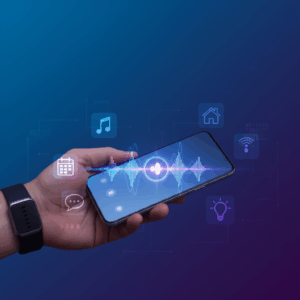History of Voice Assistant Technology
The development of voice assistant technology dates back to the 1950s, marking the beginning of machines recognizing human speech. Early systems were limited but set foundational work.
Over the following decades, significant progress in computing power and algorithms helped expand the capabilities of these systems. This evolution paved the way for modern voice assistants.
Research, funding, and innovative models throughout the late 20th century were crucial in transforming basic speech recognition into interactive digital helpers we see today.
Early Speech Recognition Systems in the 1950s
In the 1950s, Bell Labs introduced Audrey, the first machine to recognize spoken digits, marking a pioneering moment in speech recognition technology.
IBM’s Shoebox, developed around the same time, could understand 16 words and digits, showcasing early potential for speech-based interactions with machines.
These early systems were limited by hardware and vocabulary but demonstrated that computers could begin to process human language.
Advancements in Algorithms and Computing Power (1960s-2000s)
During the 1960s and 1970s, research expanded vocabulary recognition, supported by academic and government initiatives improving speech processing.
The introduction of the Hidden Markov Model algorithm in the 1970s greatly enhanced speech recognition, enabling more accurate and flexible systems.
By the 1990s, increased computing power and the internet facilitated advanced software like Dragon NaturallySpeaking, improving transcription accuracy and user interaction.
These technological advances laid the essential groundwork for the creation of voice-activated assistants and their integration into daily life.
Modern Voice Assistants and Their Capabilities
The emergence of modern voice assistants revolutionized human-computer interaction by enabling natural language dialogues on everyday devices.
Key players like Siri, Alexa, and Google Assistant have made voice control a mainstream technology used globally in many contexts.
These assistants rely on continuous improvements in AI to provide seamless and personalized experiences for users across various platforms.
Launch of Siri, Alexa, and Google Assistant
Apple introduced Siri in 2011 as the first widely accessible voice assistant, featuring conversational capabilities on smartphones.
Amazon followed with Alexa in 2014, pioneering smart speaker integration and home automation control through voice commands.
Google Assistant launched in 2016, leveraging Google’s extensive search data to deliver highly contextual and accurate responses.
Integration into Devices and Daily Life
Voice assistants are embedded in phones, speakers, cars, appliances, and wearables, making hands-free interaction effortless and widespread.
Users rely on these assistants for task organization, communication, entertainment, and connected home management every day.
This integration streamlines operations and enhances accessibility, making technology more intuitive for diverse populations.
Role of Artificial Intelligence and Machine Learning
AI and machine learning enable voice assistants to improve comprehension by learning user preferences and contextual cues.
These technologies power natural language processing, allowing assistants to handle complex queries and maintain engaging conversations.
Continuous Learning and Adaptation
Voice assistants adapt over time through ongoing training on large datasets, improving accuracy and providing personalized interactions.
Applications of Voice Assistants Across Industries
Voice assistants are increasingly transforming diverse industries by enhancing efficiency and user engagement with intuitive voice commands.
These technologies enable organizations to streamline operations and deliver improved customer experiences across various sectors.
Key industries experiencing significant impact include healthcare, education, retail, and telecommunications.
Use in Healthcare, Education, Retail, and Telecommunications
In healthcare, voice assistants help with patient monitoring, appointment scheduling, and hands-free access to medical information, improving care delivery.
Education benefits from voice technology by enabling interactive learning, providing real-time assistance, and supporting remote education platforms.
Retailers use voice assistants to facilitate shopping through voice-activated search, order processing, and personalized product recommendations.
Telecommunications companies integrate voice assistants to enhance customer service, automate responses, and simplify device management for users.
Future Trends in Voice Assistant Technology
The future of voice assistant technology is driven by innovations that will deepen interaction quality and expand functional capabilities. Generative AI promises to redefine user experiences by enabling more natural conversations.
As these technologies evolve, global market growth will accelerate, supported by increased user adoption and the integration of voice assistants into diverse environments and industries.
These trends suggest voice assistants will become smarter, more context-aware, and essential in daily life and business applications worldwide.
Enhancements Through Generative AI
Generative AI advances allow voice assistants to understand complex language nuances and generate more human-like, coherent responses tailored to individual users.
This technology improves personalization, enabling assistants to manage sophisticated tasks and maintain engaging conversations with contextual awareness.
More natural interactions will increase user satisfaction, making assistants more effective companions for work, entertainment, and daily routines.
Market Growth and User Adoption Worldwide
The voice assistant market is expanding rapidly, with hundreds of millions of users globally adopting platforms like Google Assistant, Siri, and Alexa.
Increasing device integration in smartphones, smart homes, and cars fuels this growth, meeting consumer demand for hands-free convenience.
Emerging markets and industries are also driving adoption, as voice assistants become critical tools for accessibility, productivity, and automation worldwide.







